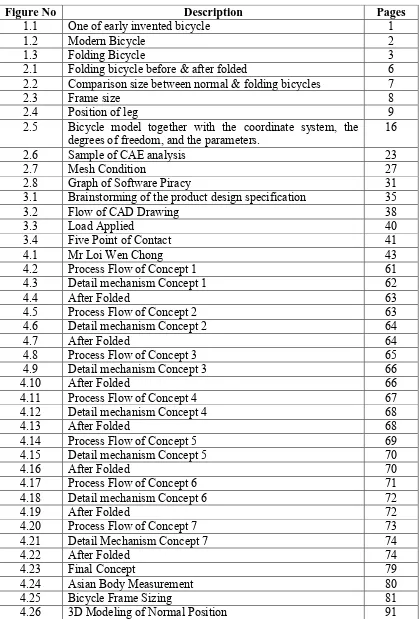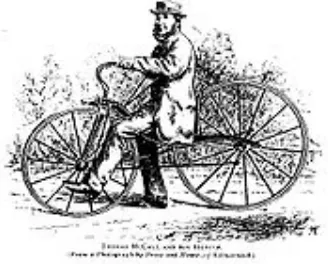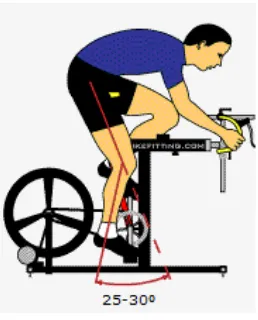I PROJEK SARJANA MUDA
AN APPLICATION OF 3D MODELING AND SIMULATION ANALYSIS IN THE DEVELOPMENT OF CONSUMER PRODUCT DESIGN
(FOLDING BIYCYLE)
NAME : ABDUL AZIM BIN ROSLAN
MATRIX NO : B040610045
COURSE : BMCD
DATE : 7 APRIL 2010
SUPERVISOR : MR SYAHIBUDIL IKHWAN BIN HJ ABDUL
II „Saya/Kami* akui bahawa telah membaca
karya ini dan pada pandangan saya/kami* karya ini
adalah memadai dari segi skop dan kualiti untuk tujuan penganugerahan Ijazah Sarjana Muda Kejuruteraan Mekanikal (Rekabentuk dan Inovasi)
Tandatangan : Nama Penyelia 1 :
Tarikh :
Tandangan : Nama Penyelia 2 :
Tarikh :
III AN APPLICATION OF 3D MODELING AND SIMULATION ANALYSIS IN THE
DEVELOPMENT OF CONSUMER PRODUCT DESIGN (FOLDING BIYCYLE)
ABDUL AZIM BIN ROSLAN
Laporan ini dikemukan sebagai
memenuhi sebahagian daripada syarat penganugerahan
Ijazah Sarjana Muda Kejuruteraan Mekanikal (Rekabentuk dan Inovasi)
Fakulti Kejuruteraan Mekanikal Universiti Teknikal Malaysia Melaka
IV “Saya akui laporan ini adalah hasil kerja saya sendiri kecuali ringkasan dan petikan yang
tiap-tiap satunya saya telah jelaskan sumbernya”
Tandatangan:……….. Nama Penulis:………..
VI ACKNOWLEDGEMENT
Ahamdulillah…
Thank God, after a four month of doing research and study, finally this report is done successfully. I wanted to share this moment and giving a big thank to my
supervisor for PSM, Mr Syahibudil Ikhwan for giving me lots of advice and always guiding me until I‟m finishing this report. To my mother and family, thank you for always understanding me due to pressure and time constrain that I faced during this critical time.
Friends, I will never forget the help that you given to me. Thanks also for being helpful when I need support and hand to help finished this report.
VII ABSTRACT
Every product produce in the world should have product development process. The process includes certain study about the customer needs, engineering requirement, Product Design Specification (PDS), Computer Aided Design (CAD) and also Finite Element Analysis (FEA). In this project, it is stress on the process of product development, starting from generate idea until analyze the design using CAE software. It is stated as one of main objective for this research to conduct and demonstrate a 3D modeling & simulation analysis in advance design software. It is also to produce innovative & creative design works in developing consumer product design. Subject matter for this project should be consumer product where the product is Folding Bicycle. Folding Bicycle is quite rare among Malaysian user, but the product is widely used in modern country such as Singapore, Japan, Europe and United States. There is potential market in Malaysia for this kind of product since there no bicycle manufacturer produce in Malaysia.
VIII ABSTRAK
Setiap produk yang dihasilkan di dalam dunia ini akan melalui satu proses yang dinamakan sebagai process pembangunan produk. Proces ini melibatkan kajian mengenai kehendak pelanggan, spesifikasi kejuruteraan,Specifikasi Reka bentuk Produk, Lukisan Berbantu Komputer, dan juga Analisa Berbantu Komputer. Projek ini menekankan process pembangunan produk, bemula daripada pembangunan idea sehinggalah kepada analisa reka bentuk menggunakan perisian Analisa Berbantu Komputer. Seperti mana yang telah dinyatakan didalam objektif projek ini, kajian yang mendalam akan dilakukan terhadap pembangunan lukisan tiga dimensi dan kajian simulasi menggunakan perisian kejuruteraan. Projek ini juga dilakukan untuk menghasilkan produk pengguna yang mempunyai nilai reka bentuk yang kreatif dan inovatif. Basikal lipat merupakan pilihan produk pengguna untuk dibangunkan didalam projek ini. Penggunaan basikal lipat agak meluas di negara maju seperti Singapura, Jepun, Eropah dan juga Amerika Syarikat tetapi tidak dinegara ini. Kajian mendapati terdapat potensi pasaran terhadap produk ini yang masih belum diterokai dimana tiada syarikat pembuat basikal di Malaysia yang menghasilkan produk ini.
Pada fasa awal pembangunan produk ini, kehendak pelanggan diambil kira sebagai satu keperluan yang penting. Data yang didapati akan ditukar kepada spesifikasi teknikal untuk menghasilkan sejumlah konsep awal produk. Konsep yang dijana akan berdasarkan specifikasi teknikal yang ditetapkan. Apabila konsep terakhir dipilih, konsep itu akan dimajukan ke dalam lukisan berbantu komputer. Selepas itu, untuk memastikan kekukuhan struktur reka bentu, kajian analisa akan dijalankan terhadap lukisan dengan menggunakan perisian analisa berbantu komputer. Nilai yang didapati melalui analisa tersebut mestilah melepasi Nisbah Kejuruteraan iaitu 2. Nilai ini mengikut spesifikasi yang telah ditetapkan oleh pihak industri.
IX TABLE OF CONTENT
CHAPTER TITLE PAGES
CONFESION IV
DEDICATION V
ACKNOWLEGEMENT VI
ABSTRACT VII
ABSTRAK VIII
TABLE OF CONTENT IX
LIST OF TABLE XIII
LIST OF FIGURE XIII
APPENDIX
1. INTRODUCTION
1.1 Background 1
1.2 Consumer Product 3
1.3 Why Folding Bicycles? 4
1.4 Objectives 4
1.5 Scope 4
1.6 Case Study 5
2. LITERATURE REVIEW
2.1 Folding Bicycles
2.1.1 What is Folding Bicycles? 6 2.1.2 Folding Bicycle Design
2.1.2.1 Size 7
X
2.1.3 Folding Method 13
2.1.4 Review Existing Product 14 2.1.5 Engineering Equation 16 2.1.6 Safety Issues of Folding Bicycles 18 2.2 Advance Design Software
2.2.1 Computer Aided Design (CAD)
2.2.1.1 Overview 20
2.2.1.2 Software Technology 21 2.2.1.3 Benefit of CAD 21 2.2.2 Computer Aided Engineering (CAE)
2.2.2.1 Overview 23
2.2.2.2 Finite Element Analysis (FEA) 26 2.2.2.3 How Does FEA Work? 26 2.2.2.4 Types of Engineering Analysis 27 2.2.2.5 Sample of CAE software 28 2.2.2.6 CAE Software in Local Industry 29
3. METHODOLOGY
3.1 Overview 32
3.1.1 Scope of Work 33
3.2 Concept Design 34
3.3 Product Design Specification 35
3.4 Concept Development 36
3.4.1 Concept-Screening Matrix 36 3.4.1.1 Concept Rating 37
3.5 Detail Design 38
3.5.1 CAD Software 39
XI
3.6.1 The Goal 41
3.6.2 The Place of the Loading Force on Frame 41
4. PRODUCT DEVELOPMENT
4.1 Result of Interview 42
4.1.1 Summary 42
4.1.2 Full Interview 43
4.2 Result of the Questionnaire 46
4.3 Result Summary 51
4.4 Quality Function Deployment (QFD)
4.4.1 Weighing 52
4.4.2 52
4.5 Product Design Specification (PDS) 54
4.6 Material Selection 55
4.6.1 Application Requirement 55
4.6.1.1 Wheel 55
4.6.1.2 Frame 55
4.6.1.3 Components 56
4.6.2 Material Consideration 57
4.6.2.1 Frame 57
4.6.2.2 Wheel 57
4.6.2.3 Component 58
4.7 Concept Generation 58
4.7.1 Morphological Chart 59
4.7.2 Concept Design 61
4.8 Concept Selection
4.8.1 Concept Screening Matrix 75 4.8.1.1 Concept Ranking 76 4.8.1.2 Concept Selection 76
4.8.2 Concept Scoring Matrix 76
XII
4.10 Detail Design (CAD) 82
4.10.1 Product Structure Tree 82
4.10.1.1 Sub-Assembly 82
4.10.1.1 Cluster Assembly 89 4.10.2 Different Perspective of View 90
4.10.3 3D Modeling 91
4.10.4 Basic Geometric 93
4.10.5 Engineering Bill of Material (E-BOM) 94
4.10.6 Folding Mechanism 96
5. ANALYSIS & RESULT
5.1 Factor of Safety (FoS) 101
5.2 Load Distribution 102
5.3 Computer Aided Engineering (CAE) Analysis 106
5.4 Result & Discussion 115
5.5 Recommendation 116
6. CONCLUSION
6.1 Overview 117
7. REFERENCE 119
8. BIBLIOGRAPHY 122
9. APPENDIXS 123
9.1 Gant Chart for PSM
9.2 Pictures during Interview Session 9.1 Drafting
XIII LIST OF FIGURE
Figure No Description Pages
1.1 One of early invented bicycle 1
1.2 Modern Bicycle 2
1.3 Folding Bicycle 3
2.1 Folding bicycle before & after folded 6 2.2 Comparison size between normal & folding bicycles 7
2.3 Frame size 8
2.4 Position of leg 9
2.5 Bicycle model together with the coordinate system, the
degrees of freedom, and the parameters. 16
2.6 Sample of CAE analysis 23
2.7 Mesh Condition 27
2.8 Graph of Software Piracy 31
3.1 Brainstorming of the product design specification 35
3.2 Flow of CAD Drawing 38
3.3 Load Applied 40
3.4 Five Point of Contact 41
4.1 Mr Loi Wen Chong 43
4.2 Process Flow of Concept 1 61
4.3 Detail mechanism Concept 1 62
4.4 After Folded 63
4.5 Process Flow of Concept 2 63
4.6 Detail mechanism Concept 2 64
4.7 After Folded 64
4.8 Process Flow of Concept 3 65
4.9 Detail mechanism Concept 3 66
4.10 After Folded 66
4.11 Process Flow of Concept 4 67
4.12 Detail mechanism Concept 4 68
4.13 After Folded 68
4.14 Process Flow of Concept 5 69
4.15 Detail mechanism Concept 5 70
4.16 After Folded 70
4.17 Process Flow of Concept 6 71
4.18 Detail mechanism Concept 6 72
4.19 After Folded 72
4.20 Process Flow of Concept 7 73
4.21 Detail Mechanism Concept 7 74
4.22 After Folded 74
4.23 Final Concept 79
4.24 Asian Body Measurement 80
4.25 Bicycle Frame Sizing 81
XIV 4.27 3D Modeling of Folded Position 92
4.28 Turn Rear Lock clockwise 96
4.29 Rear lock release from the Main Frame Body 97 4.30 Turn around the Crank Set Holder to the new position of
rear locking. 97
4.31 Locking the Rear Lock at its new position 98 4.32 Turn clockwise Key at Center of Rotation 98 4.33 Each Sliding Gear will move opposite to unlock U Lock 99 4.34 Pull the U Lock out of Center of Rotation 99 4.35 Rotate clockwise the Front Frame into the Main Body
Frame and then rotate Handle counterclockwise into the Main Body Frame.
100
5.1 Body Frame Load Applied 102
5.2 Force at Pedal 103
5.3 Force at Handle 103
5.4 Load at Crank Set Holder 104
5.5 Load at Rear Lock 104
5.6 Load at Wheel 105
5.7 Load at Hinge Main Body Frame 105
5.8 Load at Crank Arm 106
5.9 Main Body Frame Analysis 107
5.10 Pedal Analysis 108
5.11 Handle Analysis 109
5.12 Crank Set Holder Analysis 110
5.13 Center of Rotation Analysis 111
5.14 Crank Arm Analysis 112
5.15 Wheel Analysis 113
XV LIST OF TABLE
Table no Description Pages
2.1 Review of Existent Product 14 – 15
3.1 Phases of the design process 32
3.2 Product Design Specification 35
4.1 General Part Component and Its Requirement 55
4.2 Bicycle Frame Material 57
4.3 Material Properties 58
4.4 Morphological Chart 60
4.5 Concept Screening 75
4.6 Concept Scoring 78
4.7 Perspective view of E-BIKE 90
4.8 Table of E-BOM 94 – 95
LIST OF APPENDIX
No Description
1 Gant Chart for PSM 2 Picture during Interview 3 Questionnaire
4 Drafting
1
CHAPTER 1
INTRODUCTION
1.1 Background
Figure 1.1: One of early invented bicycle
(source: wikipedia, 2009)
Bicycles were introduced in the 19th century and now number about one billion
worldwide, twice as many as automobiles. They are the principal means of
transportation in many regions. They also provide a popular form of recreation, and
have been adapted for such uses as children's toys, adult fitness, military and police
2
The basic shape and configuration of a typical bicycle has changed little since the
first chain-driven model was developed around 1885. Many details have been
improved, especially since the advent of modern materials and computer-aided
design. These have allowed for a proliferation of specialized designs for particular
types of cycling.
Figure 1.2: Modern Bicycle
(Source: Wikipedia, 2006)
The invention of the bicycle has had an enormous impact on society, both in terms of
culture and of advancing modern industrial usage. Several components that
eventually played a key role in the development of the automobile were originally
invented for the bicycle such as ball bearings, pneumatic tires, chain-driven
sprockets, spoke-tensioned wheels and others.
Bicycles can be categorized in different ways depends on the function and numbers
of the rider. In this report, I will focus on the folding bicycles where one of the types
of the bicycles is. A folding bicycle is a type of bicycle that incorporates hinges or
joints in the frame that permit it to be broken down into a more compact size.
Folding bikes can be taken on public transport and into apartment buildings or
workplaces where conventional bicycles are not allowed. This facilitates
mixed-mode commuting, because a folding bike can be carried on any available transport,
and ridden when there is none. Folding bikes are also easier to transport in a car.
Folding bicycles typically cost more than non-folding bicycles of comparable
quality, because they have more parts to allow folding. This results in a more
3
market for this type of bike. As an alternative to folding, some models achieve
similar results by separating into two or more parts. These are sometimes grouped in
the same category as folding bicycles but are also referred to as break-away,
disassemble, or separable bicycles.
Figure 1.3: Folding Bicycle
(Source: Wikipedia, 2005)
1.2 Consumer Product
A consumer product is generally any tangible personal property for sale and that is
used for personal, family, or household for non-business purposes. The
determination whether consumer product is a good product requires a factual finding
4
1.3 Why Folding Bicycles?
i. Portable
Foldable bikes offer flexibility and ease of commuting via train/bus and bike
as they can be carried free on public transport. It is also great as training
bikes for cyclists travelling abroad and are super easy to pack as they simply
fold into a travel bag.
ii. Space
We can save space if using folding bicycles where we did not need any big
space to keep the bicycles. We also can keep the bicycles inside our house as
we were provided a special bag for the bicycles.
iii. Green Bicycles
As we know, this bicycles offer a healthy, green method of transport and
potential cost savings versus a car when used with public transport for longer
journeys.
1.4 Objectives:
i. To conduct & demonstrate a 3D modeling & simulation analysis in
advance design software.
ii. To produce innovative & creative design works in developing consumer
product design.
1.5 Scope:
i. To conduct a literature study on advance design software in local
industry.
ii. Design & develop conceptual modeling of consumer product according to
engineering design specifications.
5
1.6 Case Study:
i. In urban area, lots or worker going to works using public
transportation like busses and commuters. Although they used this
transportation, they still need to walk around 5-10 minutes to go to the
commuter’s station or bus stop.
ii. On family vacation or balik kampung season, usually their need to
bring along their bicycles especially for family that have a children
where love to riding bicycles around.
iii. In university area, the distance between faculties to others faculty is
not too far but still tiring if the student or lecturer only walking to go
6
CHAPTER 2
LITERATURE REVIEW
2.1 Folding Bicycles
2.1.1 What is Folding Bicycles?
Figure 2.1: Folding bicycle before & after folded
7
A folding bicycle is a type of bicycle that incorporates hinges or joints in the frame
that permit it to be broken down into a more compact size. Most 'folders' have 20
inch (51 cm) diameter wheels, or less. Folding bikes can be taken on public transport
and into apartment buildings or workplaces where conventional bicycles are not
allowed. This facilitates mixed-mode commuting, because a folding bike can be
carried on any available transport, and ridden when there is none. Folding bikes are
also easier to transport in a car.
Folding bicycles typically cost more than non-folding bicycles of comparable
quality, because they have more parts to allow folding. This results in a more
complicated design, which is more complex to manufacture. There is also a smaller
market for this type of bike. As an alternative to folding, some models achieve
similar results by separating into two or more parts. These are sometimes grouped in
the same category as folding bicycles but are also referred to as break-away,
disassemble, or separable bicycles.
2.1.2 Folding Bicycle Design
2.1.2.1 Size
Figure 2.2: Comparison size between normal & folding bicycles
8
Basically, the designs of folding bicycles are almost similar to the usual bicycle.
Folding bicycles generally come with a wider range of adjustments than
conventional bikes for accommodating different riders, because the frames are
usually only made in one size. Seat posts and handlebar stems on folders extend as
much as four times higher than conventional bikes. For even greater range of
adjustment, longer after-market posts and stems are available. While folding bicycles
are usually smaller in overall size than conventional bicycles, the distances between
center of bottom bracket, the top of the saddle and the handlebars, the primary
factors in determining whether a bicycle fits its rider, are usually similar to that of
conventional bikes. There are few types of design of folding bicycles that usually
have a similar pattern. Based on my research during interviewing the seller of folding
bicycle, he also stated that the sizes of folding bicycles are almost the same with the
normal bicycle (Interview, 2009).
a. Frame Size
Normally, the frame size is the distance between the top of the seat tube and the axis
around which the cranks rotate, measured along the seat tube. Frame sizes generally
run from 19" to 25" in increments of 1".
To find a good frame size for a rider, have the person stand in bare feet on an
uncarpeted floor. Measure the vertical distance from the floor to the head of the
femur (see drawing). Subtract 13.75".
Figure 2.3: Frame size
9
Adjusting saddle height is the second step in fitting a bike to a rider. With the rider
standing in bare feet on an uncarpeted floor, measure the vertical distance from floor
to crotch. Rotate the pedals so that the cranks are parallel to the seat tube. Adjust the
height of the saddle until the distance from the top of the bottom pedal to the top of
the saddle is equal to the rider's crotch height times 1.09 which a factor developed by
Vaughn Thomas (1967) at Loughborough University, England.
b. Saddle Adjustment
The adjustment of the saddle serves to enable the muscles to work optimally in the
longitudinal reach. As there is only one optimal longitudinal reach, there is only one
optimal saddle height. Most of the methods used at present to determine the correct
saddle height are far from optimal. We will briefly discuss a few of these measuring
methods.
Figure 2.4: Position of Leg
First there is the so-called heel-method. The heel of the shoe is placed on the pedal
and the saddle is adjusted at such a height that the leg is stretched while the pelvis is
still in horizontal position. So far no evidence, empirical nor scientific, has been
found to justify this measuring method. More importantly, this method does not take
into account the fact that the modern cycling or racing shoe has a heel jump. In



